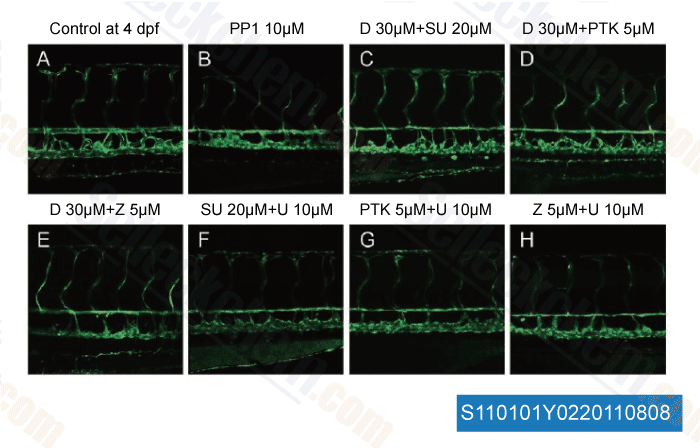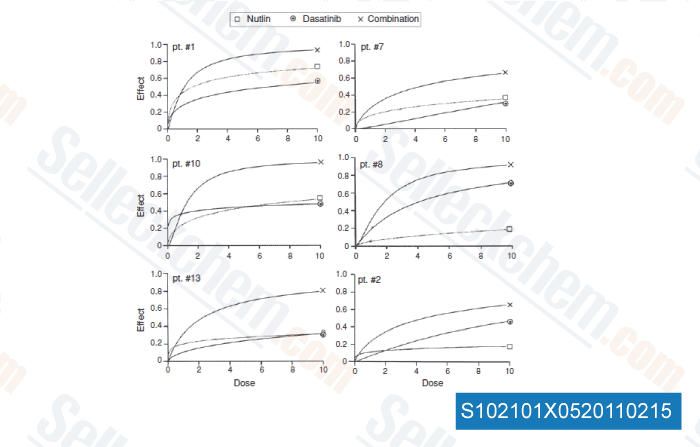|
Toll Free: (877) 796-6397 -- USA and Canada only -- |
Fax: +1-832-582-8590 Orders: +1-832-582-8158 |
Tech Support: +1-832-582-8158 Ext:3 Please provide your Order Number in the email. |
Technical Data
| Formula | C22H26ClN7O2S |
|||
| Molecular Weight | 488.01 | CAS No. | 302962-49-8 | |
| Solubility (25°C)* | In vitro | DMSO | 98 mg/mL (200.81 mM) | |
| Water | Insoluble | |||
| Ethanol | Insoluble | |||
|
* <1 mg/ml means slightly soluble or insoluble. * Please note that Selleck tests the solubility of all compounds in-house, and the actual solubility may differ slightly from published values. This is normal and is due to slight batch-to-batch variations. * Room temperature shipping (Stability testing shows this product can be shipped without any cooling measures.) |
||||
Preparing Stock Solutions
Biological Activity
| Description | Dasatinib is a novel, potent and multi-targeted inhibitor that targets Abl, Src and c-Kit, with IC50 of <1 nM, 0.8 nM and 79 nM in cell-free assays, respectively. Dasatinib induces autophagy and apoptosis with anti-tumor activity. | ||||||||||
|---|---|---|---|---|---|---|---|---|---|---|---|
| Targets |
|
||||||||||
| In vitro | Dasatinib is more effective than imatinib in inhibiting the proliferation of Ba/F3 cells expressing wild-type Bcr-Abl and Bcr-Abl mutants, with the exception of T315I. Dasatinib has a two-log (∼325-fold) increased potency relative to imatinib. Dasatinib potently inhibits wild-type Abl kinase and all mutants except T315I over a narrow range. Dasatinib directly targets wild-type and mutant Abl kinase domains and inhibits autophosphorylation and substrate phosphorylation in a concentration-dependent manner. Dasatinib displays 325-fold greater potency compared with imatinib against cells expressing wild-type Bcr-Abl. [1] The percent of colonies of TgE bone marrow cells are decreased from 100% in untreated wells to 4.12% in Dasatinib treated wells. In the presence of Dasatinib, the difference in the percentage of colonies formed by WT and TgE bone marrow cells is statistically significant. Expression of LMP2A is able to promote B lymphocyte survival and proliferation, which can be inhibited by targeting Lyn and/or c-Abl kinases through Dasatinib. [3] Dasatinib treatment inhibits Src signaling, decreases growth, and induces cell cycle arrest and apoptosis in a subset of thyroid cancer cells. Treatment with increasing doses of Dasatinib (0.019 μM to 1.25 μM) for 3 days inhibits the growth of the C643, TPC1, BCPAP, and SW1736 cell lines by about 50% at low nanomolar concentrations, while higher concentrations are required to inhibit the growth of the K1 cell line. Treatment with 10 nM or 50 nM Dasatinib results in a 9-22% increase of cells in the G1 population among BCPAP and SW1736 and K1 cells, and a corresponding 7-18% decrease in the percentage of cells in the S phase. [4] | ||||||||||
| In vivo | Dasatinib reverses splenomegaly in LMP2A/MYC double transgenic mice. Dasatinib specifically prevents colony formation by LMP2A expressing bone marrow B cells and decreased spleen size in the TgE mice. Spleen mass is significantly decreased among Dasatinib treated Tg6/λ-MYC mice when compared to the control group. Dasatinib inhibits lymphadenopathy in LMP2A/MYC double transgenic mice. Dasatinib reverses splenomegaly in Rag1KO mice engrafted with tumor cells from LMP2A/MYC double transgenic mice. Dasatinib therapy inhibits Lyn phosphorylation in B lymphocyte tumors expressing LMP2A. [3] |
Protocol (from reference)
| Kinase Assay: |
|
|---|---|
| Cell Assay: |
|
| Animal Study: |
|
References
Customer Product Validation

-
Data from [Cell Res, 2011, 21, 1080-1087]

-
Data from [Clin Cancer Res, 2011, 17, 762-770]

-
Data from [Clin Cancer Res, 2011, 17, 762-770]

-
Data from [Clin Cancer Res, 2011, 17, 762-770]
Selleck's Dasatinib has been cited by 571 publications
| B cells orchestrate tolerance to the neuromyelitis optica autoantigen AQP4 [ Nature, 2024, 10.1038/s41586-024-07079-8] | PubMed: 38383779 |
| Genomic and transcriptomic profiling of peripheral T cell lymphoma reveals distinct molecular and microenvironment subtypes [ Cell Rep Med, 2024, 5(2):101416] | PubMed: 38350451 |
| Circulating cancer-specific CD8 T cell frequency is associated with response to PD-1 blockade in Merkel cell carcinoma [ Cell Rep Med, 2024, 5(2):101412] | PubMed: 38340723 |
| Development of a stemness-related prognostic index to provide therapeutic strategies for bladder cancer [ NPJ Precis Oncol, 2024, 8(1):14] | PubMed: 38245587 |
| EFNB1 levels determine distinct drug response patterns guiding precision therapy for B-cell neoplasms [ iScience, 2024, 27(1):108667] | PubMed: 38155773 |
| Ovarian cancer ascites confers platinum chemoresistance to ovarian cancer cells [ Transl Oncol, 2024, 44:101939] | PubMed: 38489872 |
| The RIST protocol in the treatment of medulloblastomas [ AS Weber, 2024, 10.18725/OPARU-51994] | PubMed: none |
| Generation and multi-dimensional profiling of a childhood cancer cell line atlas defines new therapeutic opportunities [ Cancer Cell, 2023, 41(4):660-677.e7] | PubMed: 37001527 |
| A reversible SRC-relayed COX2 inflammatory program drives resistance to BRAF and EGFR inhibition in BRAFV600E colorectal tumors [ Nat Cancer, 2023, 4(2):240-256] | PubMed: 36759733 |
| HCK induces macrophage activation to promote renal inflammation and fibrosis via suppression of autophagy [ Nat Commun, 2023, 14(1):4297] | PubMed: 37463911 |
RETURN POLICY
Selleck Chemical’s Unconditional Return Policy ensures a smooth online shopping experience for our customers. If you are in any way unsatisfied with your purchase, you may return any item(s) within 7 days of receiving it. In the event of product quality issues, either protocol related or product related problems, you may return any item(s) within 365 days from the original purchase date. Please follow the instructions below when returning products.
SHIPPING AND STORAGE
Selleck products are transported at room temperature. If you receive the product at room temperature, please rest assured, the Selleck Quality Inspection Department has conducted experiments to verify that the normal temperature placement of one month will not affect the biological activity of powder products. After collecting, please store the product according to the requirements described in the datasheet. Most Selleck products are stable under the recommended conditions.
NOT FOR HUMAN, VETERINARY DIAGNOSTIC OR THERAPEUTIC USE.
